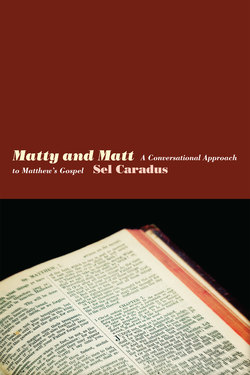Читать книгу Matty and Matt - Sel Caradus - Страница 5
На сайте Литреса книга снята с продажи.
Preface
ОглавлениеIn his essay, Kafka at Las Vegas, Alan Bennett says, “There are many perils in writing about Kafka. His work is garrisoned by armies of critics, with some fifteen thousand books about him at last count. As there is a Castle Freud, so there is a Castle Kafka…For admission, a certain high seriousness must be deemed essential, and I am not sure I have it.” I would say much the same about Matthew’s Gospel: as there is Castle Freud, so there is Castle Matthew. It is a bold outsider who, having read two, or perhaps three, of the “fifteen thousand books” about Matthew’s Gospel, would have the courage to put pen to paper and produce book number fifteen thousand and one!
A different approach is helpful: to put the topic in the form of a conversation among a group of average people, possessed of knowledge which might be obtained from the reading of books obtainable in the local secular bookstore or desultory surfing of the Internet, and united only by a willingness to share insights and/or ignorance. Such an “conversational approach” might be justified by the thought that Gospel texts were not primarily addressed to scholars but to ordinary readers (or, rather, hearers) in the first instance.
Discussions which ensue in such a group will sometimes be inconclusive. Many possibilities can present themselves to the careful reader of a text. Indeed, a glance at one or two commentaries makes the reader aware of the wide variety of opinions held by reputable scholars. Even the most basic questions about Matthew’s Gospel are in dispute:
When was it written and by whom?
Of the four gospels which begin the New Testament, was it the earliest (as was long thought and as a minority opinion continues to insist) or was it written with Mark’s Gospel already available?
Was there another document, known as “Q”, which accounts for those parts of Matthew and Luke which agree but are not found in Mark? Careers have been made on discussions about “Q” even though its existence is hypothetical!
Hostility is expressed in Matthew’s Gospel by Jesus towards the Jewish group known as the Pharisees. Does this represent the conflict which the early church was having with Jewish opponents or does it record the attitudes of Jesus himself?
And did the writer of Matthew’s Gospel feel free to put words in the mouth of Jesus to represent the theological concerns of the community at the time of writing? (The Jesus Seminar which attracted so much attention for a few years, would argue that few of the words and deeds recorded in any of the canonical Gospels have a basis in historical fact.)
The “conversational approach” can scarcely be expected to enter into such questions. It will leave many matters unsettled. One might not wish to go as far as Flaubert whose aphorism, “Stupidity is the need for conclusions” might discourage inquiry. But there is the more moderate view of John Keats who defined “negative capability” as the state of “being in uncertainties, mysteries and doubts without any irritable reaching after fact and reason.”
Those who have never participated in a study group of the kind encountered here might imagine a glum collection of old-fashioned folk, eager to confirm their traditional beliefs. But, in my experience, participants are usually lively and somewhat irreverent; humorous asides are commonplace. They are serious without being solemn.
It goes without saying but needs to be said that the characters encountered in this narrative are not based on any persons, living or dead. Deliberately, details of each are only sketched; this is not a novel and too much emphasis on the personal histories of participants distracts from the main task. Deliberately, much is left unsaid. The Gospel of Matthew, short though it is, provokes intense differences of opinion. It is hoped that readers with some curiosity about Christian scripture but with neither patience nor motivation to tackle heavyweight writings will find something of value.
The entire text of Matthew’s Gospel, adapted from the Weymouth translation (1903), is included for the convenience of the reader.
